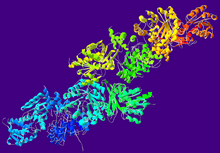Acetaldehyde dehydrogenase
| Acetaldehyde dehydrogenase (acetylating) |
|||||||||
|---|---|---|---|---|---|---|---|---|---|

Crystallographic structure of the acetaldehyde dehydrogenase from Pseudomonas sp.
|
|||||||||
| Identifiers | |||||||||
| EC number | 1.2.1.10 | ||||||||
| CAS number | 9028-91-5 | ||||||||
| Databases | |||||||||
| IntEnz | IntEnz view | ||||||||
| BRENDA | BRENDA entry | ||||||||
| ExPASy | NiceZyme view | ||||||||
| KEGG | KEGG entry | ||||||||
| MetaCyc | metabolic pathway | ||||||||
| PRIAM | profile | ||||||||
| PDB structures | RCSB PDB PDBe PDBsum | ||||||||
| Gene Ontology | AmiGO / EGO | ||||||||
|
|||||||||
| Search | |
|---|---|
| PMC | articles |
| PubMed | articles |
| NCBI | proteins |
Acetaldehyde dehydrogenases (EC 1.2.1.10) are dehydrogenase enzymes which catalyze the conversion of acetaldehyde into acetic acid. The oxidation of acetaldehyde to acetate can be summarized as follows:
Acetaldehyde + NAD+ + Coenzyme A ↔ Acetyl-CoA + NADH + H+
In humans, there are three known genes which encode this enzymatic activity, ALDH1A1, ALDH2, and the more recently discovered ALDH1B1 (also known as ALDH5). These enzymes are members of the larger class of aldehyde dehydrogenases.
The CAS number for this type of the enzyme is [9028-91-5].
Cysteine-302 is one of three consecutive Cys residues and is crucial to the enzyme’s catalytic function. The residue is alkylated by iodoacetamide in both the cytosolic and mitochondrial isozymes, with modifications to Cys-302 indicative of catalytic activity with other residues. Furthermore, the preceding sequence Gln-Gly-Gln-Cys is conserved in both isozymes for both human and horse, which is consistent with Cys-302 being crucial to catalytic function.
As discovered by site-directed mutagenesis, glutamate-268 is a key component of liver acetaldehyde dehydrogenase and is also critical to catalytic activity. Since activity in mutants could not be restored by addition of general bases, it’s suggested that the residue functions as a general base for activation of the essential Cys-302 residue.
...
Wikipedia
